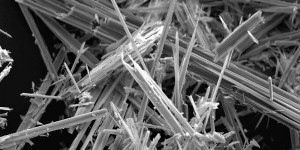 MCLinc routinely analyzes air filter and bulk samples for asbestos content. The laboratory is equipped and licensed to handle samples that are radiologically contaminated. NIOSH methods used for these analyses include Method 7400 (PCM), Method 9002 (PLM), and Method 7402 (TEM). Other analytical methods, including analysis for asbestos in water by an EPA method and asbestos in building materials by ASTM procedures are available. The laboratory is accredited by the AIHA-LAP, LLC (Laboratory Number 102797).
MCLinc routinely analyzes air filter and bulk samples for asbestos content. The laboratory is equipped and licensed to handle samples that are radiologically contaminated. NIOSH methods used for these analyses include Method 7400 (PCM), Method 9002 (PLM), and Method 7402 (TEM). Other analytical methods, including analysis for asbestos in water by an EPA method and asbestos in building materials by ASTM procedures are available. The laboratory is accredited by the AIHA-LAP, LLC (Laboratory Number 102797).
The NIOSH 7400 method is used to analyze air samples collected onto a 0.8 micrometer mixed cellulose ester (MCE) filter. Typical air samples include those collected during asbestos abatement, routine maintenance of asbestos-containing areas, or routine site monitoring. Following preparation, the filter is characterized with a phase contrast microscope (PCM) by counting the number of fibers (at least 5 micrometers long and an aspect ratio of at least 3) in 100 areas. Results are calculated on fibers per square millimeter. This method does not differentiate between asbestos and non-asbestos fibers (e.g., fiberglass).
The NIOSH 7402 method analyzes air samples collected onto a 0.8 micrometer mixed cellulose ester filter that were first characterized by NIOSH Method 7400. The purpose of this method is to confirm the presence or absence of asbestos and the relative proportions of asbestos to nonasbestos fibers. Samples are prepared on grids for analysis by transmission electron microscopy (TEM). Forty grid openings are viewed during a characterization by counting the number of fibers (at least 5 micrometers long, at least 0.25 micrometers wide and an aspect ratio of at least 3) in the 100 openings. If there are more than 100 fibers in the grid openings, then counting is stopped and the results are calculated. The resultant calculation yields proportion of fibers that are asbestos and the number of fibers per square millimeter. This method does differentiate between asbestos and nonasbestos fibers (e.g., fiberglass).
The NIOSH 9002 method or “Asbestos Identification by Polarized Light Microscopy” analyzes bulk samples for asbestos content by volume. Typical bulk samples include tile or insulation samples or equipment wipes collected prior to asbestos abatement, bulk mineral samples of materials used in manufacture, or waste characterization samples. The sample is first viewed with the aid of a stereo optical microscope to determine the presence of fibers and their proportion. If fibers are observed, relative samples from each type found are prepared for polarized light microscopy characterization (PLM). Through the use of optical techniques, the type of fiber is determined (e.g., fiberglass, cellulose, and chrysotile). That information is then coupled with the stereo optical microscope information and a report is issued. The sample is considered free of asbestos if it contains less that 1% by volume.
In addition to routine analyses of samples for asbestos, MCLinc has experience in the evaluation of methods for destroying asbestos.
